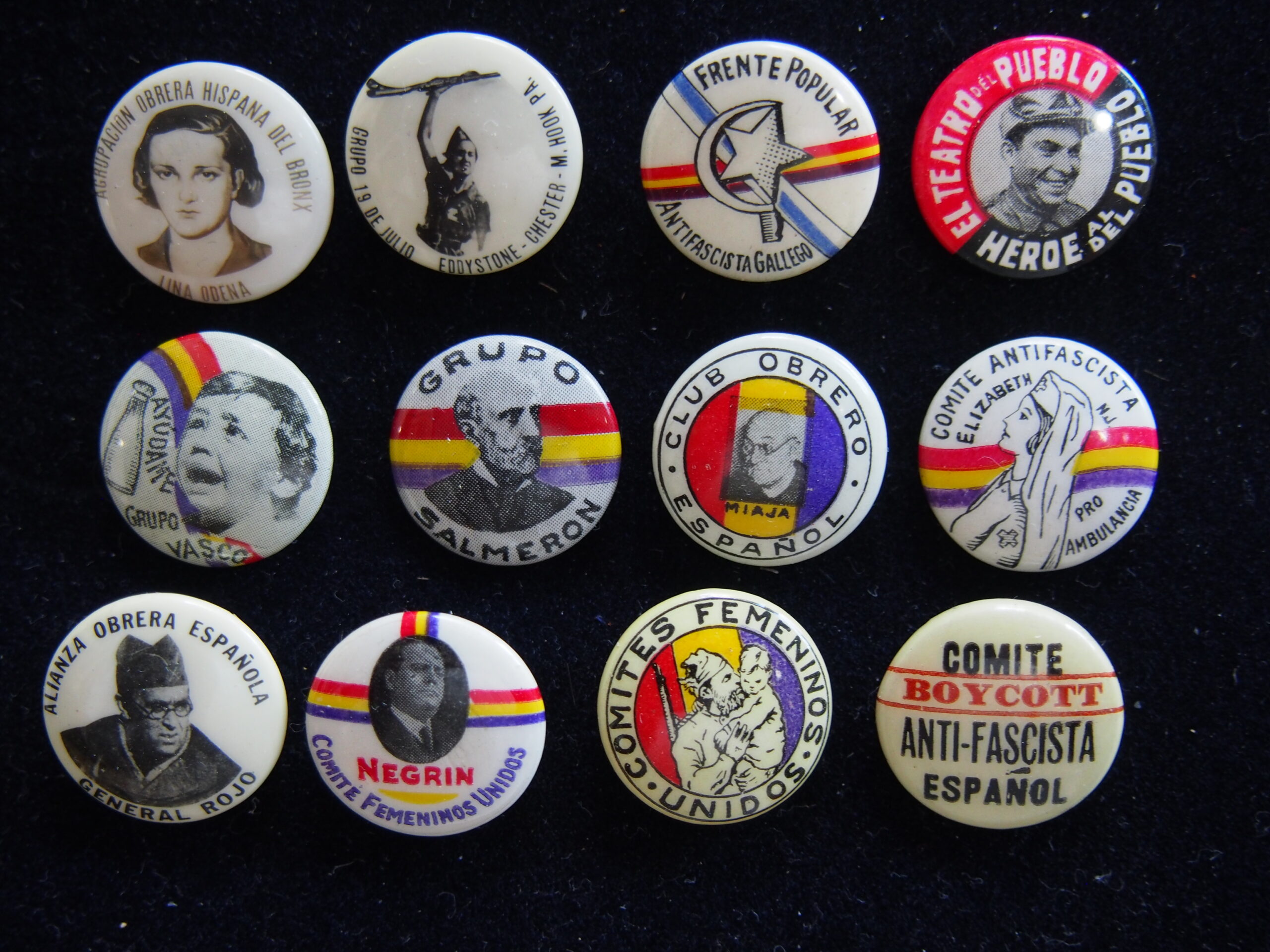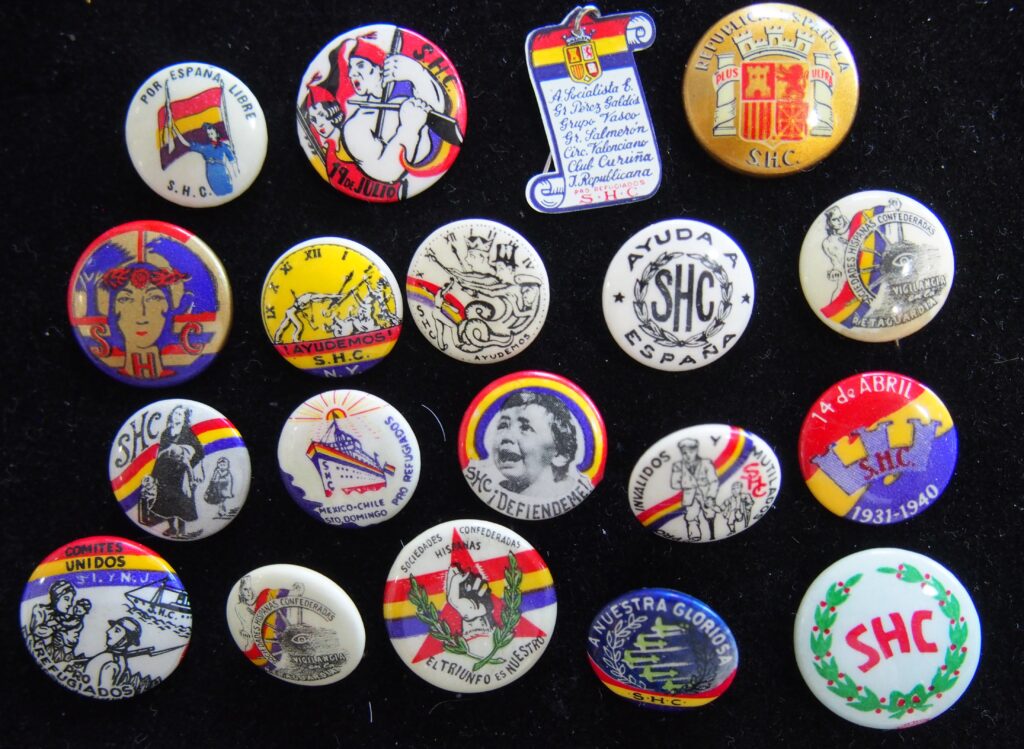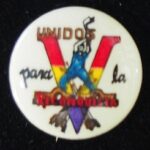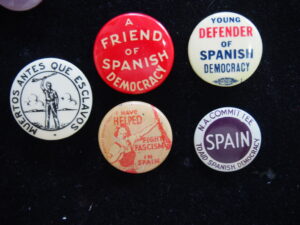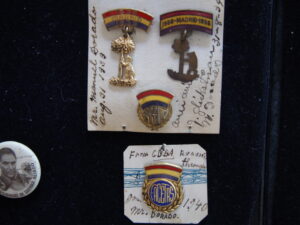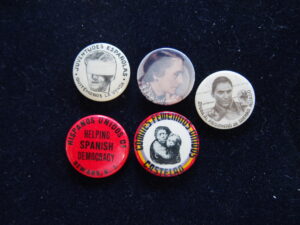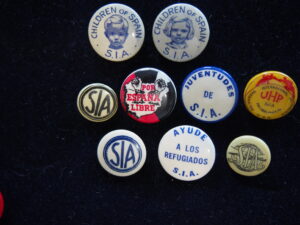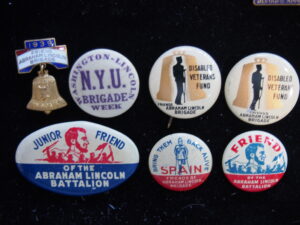Pins in Support of Spanish Democracy: A Collector’s Story
I’m a collector of American left-wing protest pins. As a radical lefty lawyer, I’ve found it to be one way to be connected to the great social movements of my lifetime and before. Although I have 9,000 pins (www.LowensteinCollection.com), none are more valuable to me than those supporting the loyalist effort in Spain. I like to think that had I been young and able-bodied in 1936, I would have had the courage to go to Spain and fight or drive an ambulance or do something bravely antifascist. I’m also fascinated by political graphics and serve on the Board of the Center for the Study of Political Graphics, an arts organization with the largest protest poster collection in the United States. As anyone who reads this magazine knows, the Second Republic may have lost the war, but they won the art. Loyalist posters are some of the best political art ever produced and played a critical role in maintaining civilian commitment during the struggle. Some of Spain’s most famous artists participated and the designs are extraordinary, often incorporating elements of cubism, fantasy, and modern technique. I have a set of postcards that were made to send to the soldiers at the front in order to maintain dedication to the cause.
Very few of the American pins, however, mimic the aesthetic of the posters. Most of them simply identify the wearer as someone who sympathizes with the antifascist struggle in Spain, belongs to a local support group, or is someone who has donated. Also, many of them are designed to raise consciousness about the victims of the war—orphans, refugees, starving children, invalids. Most of the pins are small, less than an inch, with tiny writing that might require a magnifying glass to read.
Las Sociedades Hispanas Confederadas
In the same way that the Popular Front was able to win an electoral majority in 1936, the SHC was a coming together of many domestic American organizations, as many as 80 to 100, in order to fight fascism in Spain. Some of these organizations were immigrant groups based on Spanish geography, while others were from labor organizations—communist, youth, anarchist, socialist, feminist, social democrats—who together raised considerable sums at a time when the government of the United States was enforcing a cruel “neutrality.” Most groups raised money for ambulances, but the SHC also sent a ship filled with supplies. The group of 19 pins all mention the SHC directly. Two show ships. Two very fanciful pins show an ordinary person/fighter vanquishing the fascist enemies in the form of a three headed snake-like monster—monarchist, capitalist, soldier. Both say ¡Ayudemos! (Let’s help!) And both are drawn on the face of a clock, with the heroic antifascist holding back the clock hands: Obviously, time is running out. Another shows a woman’s face backed by the strawberry tree and bear, the symbol of Madrid. Yet another shows a muscular male soldier with the SHC tricolor flag alongside a female soldier carrying the red and black anarchist (CNT/FAI) flag. Others support refugees and orphans, invalids and the disabled.
To learn more about the SHC and its magazine, España Libre, take a look at the book Fighting Fascist Spain: Worker Protest from the Printing Press by Montse Feu, a faculty member at Sam Houston State University, or Prof. Feu’s article in the July issue of The Volunteer.
SHC Member Organizations
Many pins were made by member organizations of the SHC.
Here are some initials to help: AMA is Agrupación de Mujeres Antifascistas; AOE is Alianza Obrera Española; FPE is Frente Popular Español. Women were obviously a powerful part of the antifascist movement. There are many pins of women’s groups, pins with generic women in the art symbolizing Spain or nurses, and some promoting women heroes such as Lina Odena and Dolores Ibárruri (La Pasionaria of “¡No pasarán!” fame).
Theater played a significant part in the antifascist movement. Many organizations used theatrical productions to raise money and maintain enthusiasm. I have one pinback of the El Teatro del Pueblo in the anarchist red and black with the photo of Durruti. One pin says to Remember the Mar Cantábrico, the ill-fated freighter captured by the nationals with aircraft, munitions and clothing. Two pins show a photo of Pablo Iglesias, the father of Spanish socialism and the founder of the PSOE. Another is from the Grupo Salmerón in Brooklyn, named after the President of the First Republic. General Rojo gets a couple of pins; General Miaja gets one; and there is one with often (probably unfairly) vilified Juan Negrín, President of the Second Republic, and one with Valentín Gonzalez, known as El Campesino, a communist general.
Take a look (right above) at the Comité Antifascista of Elizabeth, New Jersey pin. It advocates “Books for Franco,” but the book is in the shape of a bomb. This is possibly an acknowledgment of the embargo of military equipment and munitions that could, illegally, be skirted by labelling the containers “books.” Or it could reflect a book sale to raise money. Or, it simply acknowledges fascist anti-intellectualism. In the group mentioning the Friends of the Abraham Lincoln Battalion/Brigade, note the pin from NYU. That university, along with CCNY, contributed the largest number of students and faculty volunteers. The support groups on campus were extremely active.
I put one group of ambulance and medical funding together. One of those is on behalf of the teachers’ union raising funds for an ambulance in memory of Joe Streisand. Another is a green cross of the Medical bureau to Aid Spanish Democracy, the organization of the amazing Dr. Edward Barsky. There is a communist party ambulance fund named after Oliver Law (spelling his name incorrectly).
Most of the meanings of the pins are self-evident. Some are dramatic, such as “Muertos antes que esclavos” (Death before slavery). Others are straightforward, such as Friend or Defender of Spanish Democracy, or Rescue Spanish Refugees. Some, however, are puzzling. Take the one that is a large V. It shows a worker with an implement smashing the Falange and says “Unidos Para La Reconquista.” The Reconquista in Spanish history was the effort by Christians to re-conquer Spain from the Muslims. It took about 780 years, leading up to 1492. But here we are talking ironically of the re-conquest of Spain by the loyalist forces against the fascist defenders of the Church. This button must have been made after the fall of Madrid. The V represents the victory of allied troops in World War II. The V was a common pinback for allied war effort support, and the double V was a civil rights pin demanding victory in war and at home. This pin, I believe, is an encouragement of the allies to get rid of Franco and restore Spanish democracy. It could have been made in 1942 when Rommel was defeated in North Africa and pressure was being put on the Western allies to open a second front (eventually Sicily and the Italian campaign), or more likely, when the defeat of Hitler seemed inevitable, when Stalin, FDR (later Truman) and Churchill debated what to do about Spain (and chose to do nothing!).
People who collect pins are forced to be amateur historians. But we also honor the people who owned and proudly wore each pin and had the courage to declare to the world what they stood for. We are at an historic inflection point today. Soldiers recruited by our president and his lackey attorney general lounge on the steps of the Lincoln Memorial, poised to clear the streets.

